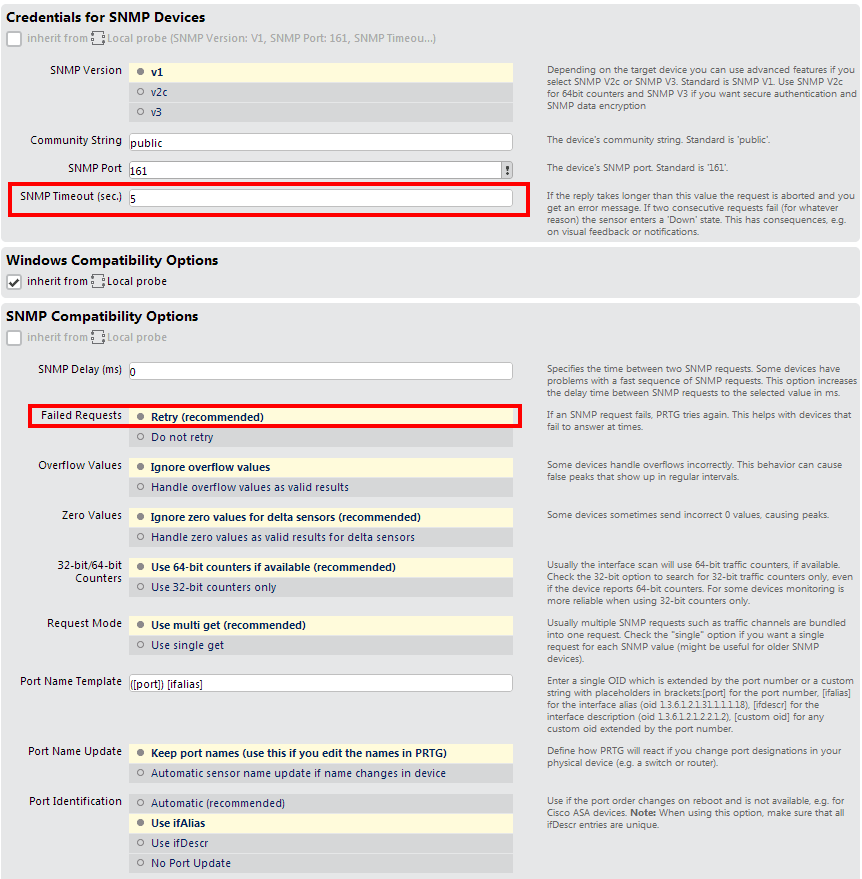We are currently monitoring a Synology NAS with bonded Ethernet interfaces using SNMP and MIBs imported from Synology. It periodically gives random false positives from SNMP causing all the sensors to go into error states, but nothing is actually wrong. What could be causing this?
11 Replies
Votes:
0
Hello,
which exact error message do the sensors then show? How long do the errors persist and do they resolve themselves after a certain time?
best regards.
Votes:
0
The error shown is: "No response (check: firewalls, routing, snmp settings of device, IPs, SNMP version, community, passwords etc) (SNMP error # -2003)" The errors resolve after about 1 minute and occur about 2 or 3 times every hour.
We are monitoring 3 synologys without bonded ethernet interfaces and they are working just fine. The 3 with bonded interfaces are the problem.
Votes:
1
Could it be a load issue on this device then? That seems to be case where the device does not always respond (in time), very much suggested by the fact that the error occurs on one of several sensors (it could also be some kind of flood protection). Please make sure that the "Retry" is enabled on "Failed Requests" in the "SNMP Compatibility Options" and you can try to slightly increase the "SNMP Timeout" in the "SNMP Credentials"-Settings (but please do not set the timeout higher than the scanning interval).
Apart from that, there is very little PRTG can do, if the device does not respond (in time) I'm afraid.
Even though it's not exactly the same (SNMP is UDP and Ping ICMP), please also try running a Ping Sensor against the target, with a Ping Counter higher than 1 (in the "Settings" of the Ping sensor), so that eventual packet loss may be shown.

Created on Feb 1, 2013 11:07:52 AM by
Torsten Lindner [Paessler Support]
Last change on Feb 4, 2013 4:52:19 PM by
Torsten Lindner [Paessler Support]
Votes:
0
Hello, we have the same error here, all synology devices with bonded Ethernet give periodically an error. I have set all settings and test another one with longer timeouts but nothing help. Before we used PRTG, we have no problems with monitoring a synology device (SNMP). Is there another people they have the same problems?
Votes:
0
id_ch, thank you for the KB Post. How long does the errors persist each time? And what is the exact error message shown by the sensors?
Also can you record the SNMP communication with the Synology NAS with Wireshark? Do you then see the same errors in the capture?
Votes:
0
Hello Torsten, the error message is: "No response (check: Firewalls, routing, snmp settings of device, IPs, SNMP version)". The error is not persist, the next check and all snmp checks are god. The Wirsharkrecord i dont have at this time. But i make a record in the next days.
Votes:
0
This looks like there is an issue with keeping the SNMP communication towards the target. It seems the communication is quite unstable. Bear in mind, SNMP is UDP based, so packets can be lost. And also, devices tend to "ignore" SNMP requests in high load situations. It could be either of those here.
Votes:
0
Now i have recording the snmp traffic from prtg to synology. we see that the request is send from the prtg, but the response come back after 1 minute. Then the problem is not prtg, but it is somewhere in the network or with the synology hardware. Now i have set the scan interval to 5 minutes and the snmp timeout with 120 Seconds, until now it works, but a definite answer I see only in a few days. Thanks for the input.
Votes:
0
I apologise for the late reply. Did you already check with Synology directly? Do they have an explanation for this by any chance? Do the alerts correlate with high (CPU / Memory) load on the NAS by any chance?
Votes:
0
i have now open a ticket by synology. On the synology devices are no high load (CPU/Memory/Disk) if the sensor reports an error.
Votes:
0
Still for information, the synology support has nothing found on the device. No errors, no performance issues at this time when the error is occurred. I have now set the snmp timeout again to 120 seconds and the check interval to 5 minutes.
Add comment